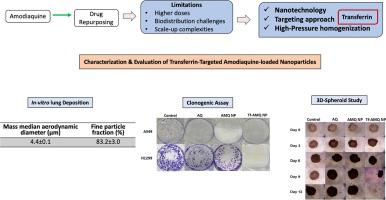International Journal of Pharmaceutics ( IF 5.3 ) Pub Date : 2021-08-23 , DOI: 10.1016/j.ijpharm.2021.121038 Vineela Parvathaneni 1 , Snehal K Shukla 1 , Nishant S Kulkarni 1 , Vivek Gupta 1

|
New drug discovery and development processes encounter significant challenges including requirement of huge investments and lengthy time frames especially in cancer research field. Repurposing of old drugs against cancer provides a possible alternative while associated scale-up complexities with production of nanoparticles at industrial scale could be overcome by using a scalable nanoparticle technique. We previously described use of polymeric nanoparticles for inhaled delivery of amodiaquine (AQ) for non-small cell lung cancer (NSCLC) treatment. In this study, targeting potential of transferrin ligand conjugated inhalable AQ-loaded nanoparticles (Tf-AMQ NPs) was investigated against NSCLC. Tf-AMQ NP (liquid formulation) demonstrated an aerodynamic diameter of 4.4 ± 0.1 µm and fine particle fraction of 83.2 ± 3.0%, representing AQ deposition in the respirable region of airways. Cytotoxicity studies in NSCLC cell line with overexpressed transferrin receptors shown significant reduction in IC50 values with Tf-decorated AQ-loaded nanoparticles compared to AQ or non-targeted NPs, along with significant apoptosis induction (caspase assay) and reduced % colony growth in A549 and H1299 cells with Tf-AMQ NP. Furthermore, 3D spheroid studies (~7-fold reduction in spheroid volume compared to AMQ NPs) explained efficiency of conjugated nanoparticles in penetrating tumor core, and growth inhibition. AQ’s autophagy inhibition ability significantly increased with nanoparticle encapsulation and transferrin conjugation. In conclusion, amodiaquine can be an assuring candidate for repurposing to consider for NSCLC treatment while delivering inhalable transferrin conjugated nanoparticles developed using a scalable HPH process to the target site, thus reducing the dose, side effects.
中文翻译:

可吸入转铁蛋白功能化阿莫地喹纳米粒子的开发和表征——在非小细胞肺癌 (NSCLC) 治疗中的疗效
新药发现和开发过程面临重大挑战,包括需要巨额投资和漫长的时间框架,尤其是在癌症研究领域。重新利用抗癌药物提供了一种可能的替代方案,而与工业规模纳米颗粒生产相关的放大复杂性可以通过使用可扩展的纳米颗粒技术来克服。我们之前描述了使用聚合纳米粒子吸入递送阿莫地喹 (AQ) 用于非小细胞肺癌 (NSCLC) 治疗。在这项研究中,研究了转铁蛋白配体偶联的可吸入 AQ 负载纳米粒子 (Tf-AMQ NPs) 对 NSCLC 的靶向潜力。Tf-AMQ NP(液体制剂)的空气动力学直径为 4.4 ± 0.1 µm,细颗粒分数为 83.2 ± 3.0%,代表气道可吸入区域的 AQ 沉积。具有过表达转铁蛋白受体的 NSCLC 细胞系的细胞毒性研究显示 IC 显着降低与 AQ 或非靶向 NPs 相比,Tf 修饰的 AQ 负载纳米粒子的50 个值,以及显着的细胞凋亡诱导(半胱天冬酶测定)和 Tf-AMQ NP 在 A549 和 H1299 细胞中的集落生长百分比降低。此外,3D 球体研究(与 AMQ NP 相比,球体体积减少约 7 倍)解释了共轭纳米粒子在穿透肿瘤核心和生长抑制方面的效率。AQ 的自噬抑制能力随着纳米颗粒封装和转铁蛋白结合而显着增加。总之,阿莫地喹可以作为一个可靠的候选药物,重新考虑用于 NSCLC 治疗,同时将使用可扩展的 HPH 工艺开发的可吸入转铁蛋白偶联纳米颗粒输送到靶位,从而减少剂量和副作用。











































 京公网安备 11010802027423号
京公网安备 11010802027423号